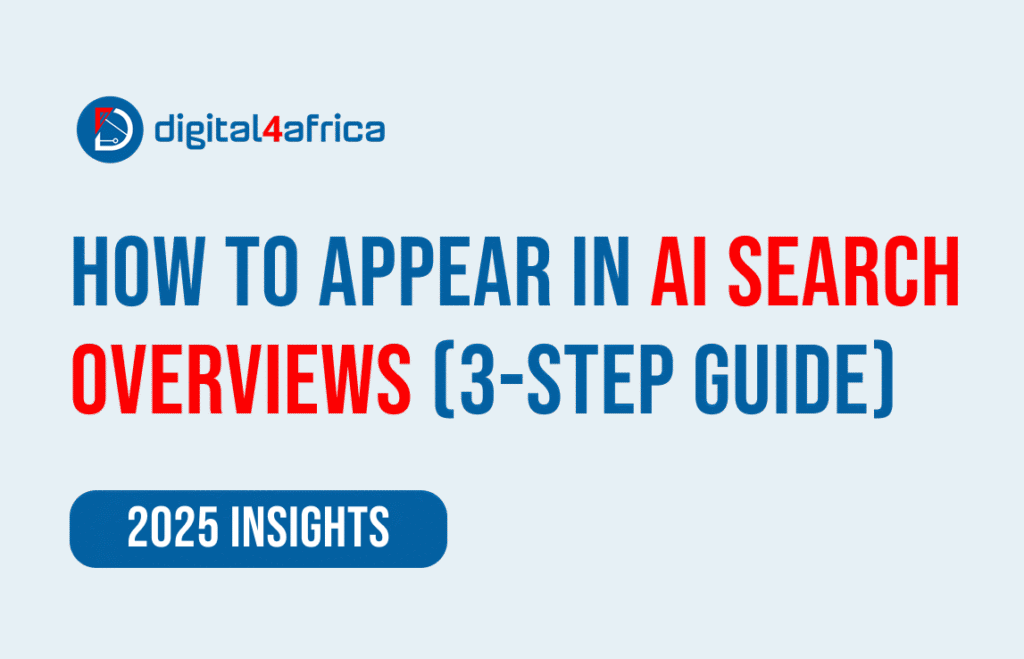How to Appear in AI Search Overviews (3-Step Guide)
Everyone’s panicking about AI killing SEO, but Google’s latest data tells a different story. If you want to appear in AI search overviews, this post will improve your approach to online visibility. In the next 8 minutes, you’ll discover why AI hasn’t killed SEO, what Google is actually doing to evolve search, and three actionable strategies to make your content visible to both humans and AI systems—giving you a competitive edge while others retreat in fear.
Why AI Search Overviews Don’t Replace Websites
“Is SEO dead?” “Should we stop investing in content?”. If you’ve been wrestling with these questions, you’re not alone. Here’s what the data shows: while the landscape is shifting, the opportunities for smart professionals have never been greater.
Google isn’t trying to eliminate websites—they’re trying to enhance user experience. The introduction of AI Overviews is about delivering answers faster while still driving qualified traffic to valuable resources. Think about it: when you search for “best CRM for small business,” the AI gives you the overview; your quality website provides the depth, reviews, and guides.
How to Position Your Content for AI Visibility
Here’s the insight most people miss: AI rewards E-E-A-T (Experience, Expertise, Authoritativeness, Trust), which is often built on consensus.
f you’re developing a revolutionary project management methodology, don’t position it as “completely different.” Instead, frame it as “building on proven Agile principles with these three key improvements.” You’re linking new ideas to existing concepts that AI systems already understand and trust. This is a core principle of AI SEO.
A Simple Test: Are You Visible to AI Right Now?
Before you panic about AI stealing your traffic, run this simple test: Search for problems your product or service solves, but search as if you know the solution exists without using your brand.
If you don’t appear in the results, ask yourself: “Why isn’t my company in this result set?” This isn’t an AI problem—it’s a positioning and content problem that existed before ChatGPT was even a concept.
Your Three-Step Action Plan to Appear in AI Search Overviews
Step 1: Ensure AI Crawlers Can Access Your Site
Many websites are accidentally blocking AI crawlers through overly aggressive DDoS protection or CDN settings. Check with your IT team to ensure that legitimate LLM bots can access your content. If you’re using Cloudflare or similar services, review the default bot protection settings.
Step 2: Master Core SEO Fundamentals with Rank Math
This isn’t the time to abandon SEO basics—it’s time to perfect them. Modern tools like Rank Math SEO make it easier than ever to ensure every page has proper focus keywords, meta descriptions, and on-page optimization. AI systems still rely on these signals to understand your content’s relevance and authority.
Step 3: Create Content That Directly Answers Questions
When someone asks ChatGPT or Claude about your industry, what questions are they likely to ask? Create content that directly answers these queries with clear, comprehensive solutions. Your goal is to become the definitive source that AI systems reference when discussing your expertise area.
Frequently Asked Questions (FAQ) about AI and SEO
Creating an FAQ section is one of the most powerful ways to appear in AI Overviews because you are directly providing answers in a structured format.
- Q: Will AI Overviews reduce my website traffic? A: Not necessarily. While some simple query traffic may decrease, AI Overviews often cite and link to sources for complex topics, driving highly qualified and engaged users to your site. The goal is to be that cited source.
- Q: What is the most important ranking factor for AI SEO? A: There is no single “most important” factor. However, a combination of E-E-A-T, clear and structured content that directly answers user questions, and strong technical SEO fundamentals are crucial for AI visibility.
- Q: How is optimizing for AI different from traditional SEO? A: It’s an evolution, not a replacement. AI SEO places a greater emphasis on natural language, conversational queries, and structured data (like Schema). Traditional SEO provides the foundational authority and relevance that AI systems use to find and trust your content.
The Opportunity: Adapt Faster Than Your Competitors
While your competitors worry about AI killing their visibility, you can be capturing market share by adapting faster. The businesses that thrive will be those that understand how to work with AI, not against it.
Remember: every major shift in digital marketing has created winners and losers. Email marketing didn’t kill direct mail for everyone—it eliminated those who refused to adapt while creating millionaires among early adopters. Social media didn’t destroy traditional advertising—it rewarded those who learned to tell stories in new formats.
Your Next Move
The question isn’t whether AI will change how people find information online—it already has. The question is whether you’ll position yourself to benefit from this change or get left behind while waiting for things to “go back to normal.”
Start with the visibility test I mentioned. Spend 30 minutes this week searching for your industry’s key problems and solutions. Take notes on what appears, what doesn’t, and where you see opportunities to provide better, more comprehensive answers.
The future of online visibility belongs to those who combine AI understanding with human insight, technical competence with creative thinking, and strategic patience with tactical urgency.
The SEO game isn’t over—it’s just getting more interesting.
Written by Manasseh Adina | Web Developer at DIgital4Africa.


